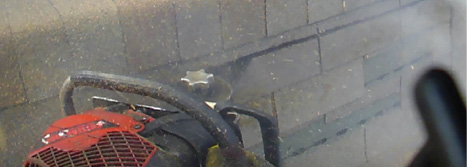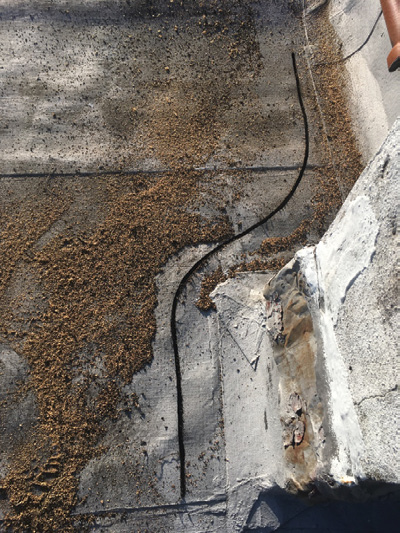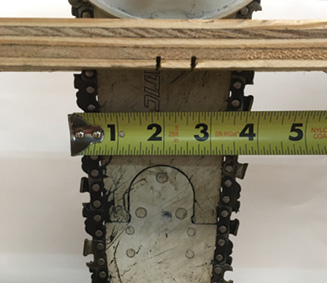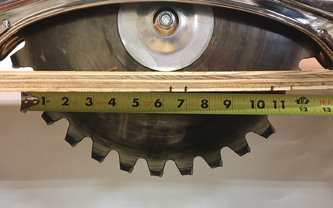
By Tim Anderson
You arrive for your night work tour with your assigned squad company and check your equipment, among which is a complement of saws. As the dinner bells ring, you are dispatched on a dwelling fire and arrive to find a boarded-up vacant structure with medium smoke throughout. The incident commander (IC) orders your company to assist in forcible entry. You grab a fire service chain saw and quickly adjust the depth gauge to give you maximum cut depth. As you plunge cut the plywood and 2 × 4 strong backs holding it in place, you’re able to quickly make entry, allowing the engine company to make fast work on the fire and providing ventilation as the truck companies search.
Back at the firehouse with your equipment restored and dinner complete, you settle in for Monday Night Football but are dispatched to another dwelling fire. This one is in a newly constructed townhome. Heavy fire is on the second floor and extending to the attic. The roof of the original fire dwelling is compromised. The IC orders you to put inspection holes in the Bravo exposure to check for extension. Aware that the roof is lightweight wood truss, you again choose the chain saw and set the gauge to a minimum depth to ensure your cuts compromise only the decking and not the trusses below. Determining no extension, you take up (photo 1).
The rest of your night passes uneventfully. As you are preparing for shift change, you are dispatched to a vehicle rescue. You arrive to find that a tree has fallen on a four-door sedan; the driver is conscious but pinned by the roof. You select an arbor chain saw you keep on your squad for just such occasions and begin to remove crucial limbs while the rest of your team stabilizes the vehicle and prepares for a roof removal. Sufficient limbs are removed, the extrication goes smoothly, and the occupant is removed with nonlife-threatening injuries. You go home tired but satisfied after a challenging, successful shift.

(1) A fire service chain saw with a depth guard is used to vent a peaked roof. (Photos by author.)
History
Chain saws as we know them today had their genesis in the late 1700s as medical devices for cutting bone. In the 1800s, wire type saws evolved into the first structured saw called an “Osteotome,” which was a set of cutting teeth rotating around a fixed bar-type track powered by a hand crank.
The saw remained a largely medical instrument until the early 1900s, when inventors in several nations began serious work on the wood-cutting chain saws we know today. In 1929, Andreas Stihl (founder of the now international tool manufacturing company STIHL) patented the first gasoline-powered chain saw, and the race was on.
Following World War II, advances in metal technology allowed for saws to be constructed with lighter components. This major advance meant that saws that were once a two-person operation and weighed more than 100 pounds could now be carried and operated by one person. Chain saws were now personal tools; this vastly expanded their field of use. While wildland firefighters quickly adopted chain saws for felling trees, various fire departments across the country began experimenting with them for structural firefighting. However, the chains dulled rapidly, limiting their acceptance as a go-to tool for ventilation and forcible entry.
That all changed with the invention of carbide- (an extremely hard compound formed by bonding carbon with other materials like tungsten, boron, or titanium) tipped chains in the 1980s. With chains that stayed sharper longer and could cut a variety of materials, the chain saw grew to be a versatile, respected tool in the American fire service.
The introduction of the chain guard depth gauge in the 1990s greatly increased the safety factor, winning over any previous safety-concerned naysayers. With these advances, the chain saw has proven to be a reliable tool for the fire service.
Saw Anatomy/Types
Based on the maintenance the average saw operator can be expected to perform, chain saws have three essential parts: the engine, the chain, and the guide bar on which the chain tracks. Most chain saw engines are two-stroke, gasoline-powered engines fueled with a 50:1 gas/oil mixture. This enables the saw to be operated upside-down with a continuously lubricating system. Most chain saws have a separate bar and chain oil system that lubricates the chain and prevents the bar from warping from excessive heat. The engine body includes the throttle trigger, which is to be operated by one hand, and a handle that wraps around most of the body to allow the operator to hold the saw in various positions with the other hand. In addition to gas-powered saws, there are specialized hydraulic saws for cutting concrete and for other unique applications.
To cut, the chain saw engine drives a sprocket that turns a cutting chain around a tracked steel guide bar. The guide bar can range in length from 10 inches for small pruning saws to 60 inches for felling large trees. Most fire service-specific chain saws for structural operations range from 16 inches to 20 inches; longer bars are used for wildland operations. Bars in the 18- to 20-inch range are ideal for ventilation operations; they provide a balance of reach and maneuverability. Some fire service chain saws include a chain guard depth gauge and an adjustable guard that wraps around the length of the bar and allows the operator to limit the exposed chain. This feature protects from the exposed cutting surface and also allows operators to set a maximum cut depth, which is a great advantage during ventilation operations on roofs of lightweight construction.
The cutting chain is a continuous loop of metal links that track around the guide bar. There are various configurations, but all chains include drive links that track within the guide bar and are pushed/pulled by the sprocket and cutting links that contain cutting teeth of various types to carve out or grind away material.

(2) Shown are five chain saw options for fire service use: (from left to right) small arbor chain saw with chipping blade, heavy duty chain saw with carbide-tipped blade, chain saw with blade depth guard and carbide-chipping blade, chain saw with blade depth guard and bullet blade, and specialized concrete-cutting chain saw with diamond blade.
Cutter Types
The fire service uses three primary types of cutters. The first is a traditional chipping cutter designed to cut wood. Chipping cutters have a curved, pitched, steel blade designed to carve out a chip of the wood material they are cutting. Chipping chains are what most people associate with a chain saw and are the most readily available. They are excellent for wildland operations and a good option for companies with technical rescue responsibilities where trees may have to be removed from or around an incident scene.
The second type of cutter is the carbide or carbide-tipped cutter. Because traditional steel chipping blades dull rapidly when cutting materials other than wood, a harder material was needed for chain saws to be practical for structural ventilation and forcible entry work. Carbide is an extremely hard material found on chains of several brands of chain saws. One option has a traditional chipping tooth design, but the entire cutter is made of carbide. Several manufacturers make carbide-tipped chains with a carbide insert affixed to a steel cutting tooth to provide greater durability and cutting flexibility. There is also a bullet-shaped chain that features a carbide insert with a cutting surface that is shaped like a half-moon instead of the chipping shape. The bullet chain grinds more than it cuts, reducing the chances of kickback (a phenomenon where the directional energy of the saw reacts to the material being cut and forces the saw up toward the operator), thus increasing operator safety. All carbide chains cut a variety of materials, including light-gauge metal.
Finally, there are specialized diamond chains for cutting materials like concrete. These chains are used primarily by technical rescue companies for structural collapse operations and are often found on saws dedicated for such tasks (photo 2).

(3) The cut flex of a chain saw allows for curved cuts if necessary. The cut shown here is not necessarily a practical cut for roof ventilation. It is shown to demonstrate the flexibility of a chain saw.
Chain Saws vs. Rotary Cut-Off Saws
There are many reasons chain saws have become a fire service standard. With the availability of a variety of saw types, sizes, and cutting chains to choose from, chain saws are ideal for all fireground cutting operations except metal-based forcible entry. The benefits of chain saws for fire service uses become more apparent when we compare them with rotary cut-off saws.
Pros
Weight. Heavy-duty chain saws for fire service use average around 23 pounds. The rotary saw averages around 28 pounds, or five pounds heavier. An extra five pounds is a big difference when climbing a ladder or operating above your head, especially as fatigue increases throughout a job. As self-contained breathing apparatus mysteriously grow heavier with each new standard, weight savings are critical for operational efficiency and reducing fatigue, which in turn reduces firefighter injuries.
Cut depth. The unique bar and chain design of a chain saw gives tremendous cutting flexibility, particularly when using an adjustable depth gauge. Consider a chain saw with a 20-inch bar. Any point along the bottom, top, or tip of the saw is a usable cutting surface, depending on the skill of the operator. The 20-inch bar provides the reach or depth necessary to make the cut whether cutting a thick roof, making a far side cut on a peaked roof, cutting through a wall for rapid intervention team operations, or cutting a window board up above the head. Compare that to the maximum five-inch cut depth of a 14-inch rotary blade (the largest blade accepted on most rotary saws), and the flexibility of the chain saw is obvious. Using a depth guard, that same 20-inch saw can be locked out to only one-half inch of cutting surface if desired. Not only is this useful for ventilation above lightweight roof components or an additional safety factor for inexperienced operators, but it also provides a safe option for cutting materials around victims in rescues. Rotary saws have no depth gauge option; the operator regulates cut depth by feel.
Cut flex. This is the ability of a blade to move within the kerf (the blade-width slit cut) it creates as it cuts. The narrower the blade, the greater the rotational movement within the kerf, and vice versa. A scroll saw, for example, has a very fine blade that enables intricate curves to be cut for decorative woodworking. A typical carpentry circular saw, however, can cut only in straight lines because of the width of the blade that passes through the material. If a circular saw is rotated within a cut, it can react violently and be forced out of the material. A chain saw lies somewhere in the middle. The bar/chain is narrow enough to make arching cuts with an angled kerf and then return to straight right-angle cuts (photo 3).
Conceptually, cut flex is the reason a chain saw, not a rotary saw, is used to create a sculpture in ice or a tree trunk. If you picture a chain saw held perpendicularly to the cutting material with the bar passing through the cut, the same amount of bar (about four inches) passes through the cut if the operator cuts at a depth of two inches or 20 inches. However, to get the full depth out of a 14-inch rotary blade, 12 to 13 inches of blade passes through the material from where the first tooth enters and the last tooth exits the kerf. Any rotational motion of the saw while the blade is in the kerf results in binding and potentially violent kickback. A chain saw, however, has a narrow enough bar so that the operator can make a curved cut without removing the saw from the material and without kickback (photos 4-5).

(4) Cut flex is achieved because the blade is relatively narrow in relation to the cut material. When held perpendicular to the material, a chain saw has roughly four inches of blade through the material, as opposed to more than 11 inches with a 13-inch rotary blade.

(5) Cut flex is achieved because the blade is relatively narrow in relation to the cut material. When held perpendicular to the material, a chain saw has roughly four inches of blade through the material, as opposed to more than 11 inches with a 13-inch rotary blade.
“But we’re not carving a statue,” you say, “we’re cutting 4 × 4s in the roof, so why does this matter?” The cut flex of a chain saw translates into a more forgiving saw, particularly as firefighter fatigue increases throughout a fire. The aim may be a 4 × 4 at perfect right angles; but, as reality sets in, the versatility to make nonlinear cuts is a great asset. It also makes it possible to make a three-cut roof vent, a particularly useful technique on a pitched roof where the operator must reach out and across his body to make the far side cut. Instead of a far side cut and a separate bottom cut, the operator can cut one far side sloping cut back to the roof ladder, reducing the number of resets necessary to complete a roof vent (photo 6).

(6) The cut flex of a chain saw allows for curved cuts if necessary. One advantage is that the operator can make a three-cut vent on a peaked roof by drawing the chain saw back to the roof ladder for the far cut in one motion as opposed to making four cuts.
Cons
There are three primary drawbacks to chain saws.
Safety. The first is the obvious safety factor. High-powered rescue saws of any type, whether chain saws, rotary saws, or reciprocating saws, are inherently dangerous tools and demand a high level of training. In some cases, chain saws have more than 20 inches of exposed cutting service on the top and bottom of the bar.
There are several safety mechanisms designed to improve operator safety.One is the chain brake, which is activated by pushing the front handle guard forward; this activates a lock around the saw clutch, stopping the rotation of the chain in a fraction of a second. The operator can activate the chain brake by choice for added safety while the saw is running on the fireground, which might be done between cuts on the roof or when handing a running saw to another firefighter. More importantly, however, the chain brake is designed to activate automatically by striking the wrist of the operator should the saw experience kickback. Should this occur, the natural motion of the operator’s wrist activates the chain brake, stopping the chain before it contacts the operator’s body.
A second safety option is the blade depth guard. Though designed to limit the depth of the cut for safely performing roof operations on lightweight construction, the depth guard also effectively covers between 50 percent and 100 percent of the bar, depending on how much of the bar the operator leaves exposed. Experienced users may keep the depth guard fully retracted by default, but members in training or departments in slower areas will benefit greatly by using the depth guard to reduce the exposed cutting surface.
Throwing the chain. The chain may come loose from the bar and the saw will be out of service for the duration of the operation. Throwing the chain can happen for several reasons. The most common is an incorrectly tensioned chain or striking an unanticipated material in the cutting service, such as heavy-gauge steel, that the saw is not intended to cut. Even a dull rotary saw blade will provide some cutting action; but if the chain is thrown, the saw is useless and it is time for an ax. Proper maintenance and training can greatly reduce the risk of this issue.
Time-consuming maintenance. Chain saws are very time consuming to clean, particularly after use on a heavily tarred flat roof. Although this does not present a problem in rural areas, busier departments may want to consider a backup saw to place in service while the frontline saw is down for cleaning. You could argue that cleaning well-worn tools is one of the finer privileges of the fire service and not a drawback at all, but it can be a pain at 3 a.m.
Firefighters are confronted with a variety of unknown emergencies every time they go out the door. The uncertainty of the job demands tools with the flexibility to match. For fireground forcible entry, ventilation, and certain technical rescues, chain saws provide a flexible cutting tool capable of providing an assortment of cutting options. Be sure the chain saw on your rig is ready to go; if you don’t have one, there are many good options from which to choose.
Author’s note: Special thanks to the Wyndmoor Hose Company for use of its acquired structure.
Tim Anderson is a firefighter in the Philadelphia (PA) Fire Department assigned to Squad Co. 72. He is a technical rescue instructor and the owner of Anderson Rescue Solutions LLC, a company that designs innovative products for the fire, rescue, and tactical communities.

